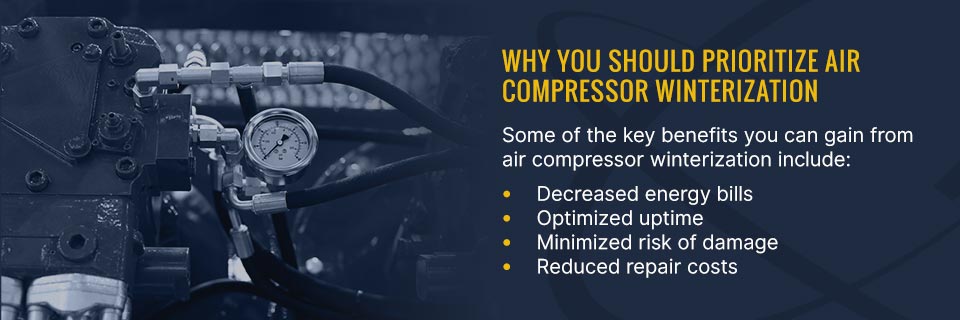As you manage demand for production and efficiency, keeping your equipment running optimally is a vital concern. As you invest in assembly, overhead costs and training, you need to ensure you get maximum productivity back from your operations. One significant way to help improve cost-efficiency at your work site is to ensure your air compressor systems are properly maintained and prepared for winter weather.
Planning ahead for weather changes is critical to maintaining optimized air compressor performance. When the weather turns colder, you want to follow best practices to winterize your equipment and ensure it can last the winter without any damage or operating issues. If you’re considering your options for winterization, you’ll want to keep a few best practices in mind.

Why You Should Prioritize Air Compressor Winterization
Investing time in air compressor winterization can have long-term advantages in protecting your operations and reducing overhead expenses. Some of the key benefits you can gain from air compressor winterization include:
- Decreased energy bills: Proper winterization and operation of your equipment can help you save on energy bill costs.
- Optimized uptime: With air compressors operating optimally, you can cut down on overhead expenses and reduce downtime on the job.
- Minimized risk of damage: Your air compressor’s overall maintenance health can decrease the risk of product moisture damage and associated costs.
- Reduced repair costs: Acting proactively to protect your air compressors can help you avoid future repair expenses.
8 Tips on How to Keep Your Air Compressor From Freezing
Keep these tips in mind to ensure your air compressor is ready for winter.
1. Service Your Air Compressor System Strategically
Regular maintenance is one key consideration when you service air compressor systems. It is critical to protect your equipment by checking on crucial components and ensuring they can handle the day-to-day workload. When you’re preparing for the cold winter months, having a well-maintained system is essential to protecting your air compressor from damage. We recommend scheduling maintenance and inspections in late spring and late fall to prepare for the summer’s rising heat and the winter’s cold.
2. Inspect Insulation for Heat Leaks
When you conduct an overall maintenance check bi-annually, be sure to look for heat leaks in your system. If heat can escape from your equipment, it can potentially increase the risk of the systems freezing. Carefully inspect your equipment for any place where critical heat could get out.
3. Check Weatherstripping for Wear and Tear
To help protect your system, inspect your equipment for wear and tear. If your weatherstripping looks worn or damaged, you should replace it immediately to ensure it has sufficient insulation during the cold months.
4. Check Tanks for Condensation
During the winter months, your air compressor tanks can accumulate moisture and freeze in cold temperatures. To prevent this operating issue, you’ll want to schedule inspections a few times weekly to ensure your tanks are not experiencing condensation buildup. Monitor your equipment for a sudden increase in moisture, as it may indicate a secondary cause you’ll need to address to protect your system.
5. Winterize the Condensate Drains and Bowls
Another way to help protect your tanks is to winterize your equipment’s condensate bowls and drains proactively. Ensure your outdoor drains have heat trace tape on any exposed parts of the drain lines to shield them from below-freezing temperatures.
6. Adjust the Louvers
When heat escapes your air compressor, you can take advantage of louvers to help capture and recirculate it. During the winter, you’ll want to direct the heat toward the compressor to help keep the system warmer. You could also send it to a nearby room to help decrease energy bill costs. If you can’t control your compressor louvers by a thermostat, you can adjust them manually to use heat more effectively.
7. Try a New Heater Solution
If you cannot preheat lubricant to use with cabinet heaters, you may want to use ambient heaters to maintain a higher lubricant temperature. That way, you can help protect the compressor from motor wear. Whenever you use cabinet or ambient heaters, perform regular inspections to ensure they’re operating correctly and safely.
8. Use Heat Trace Tape
Along with using heat trace tape to protect exposed areas of your drain line, you can also consider using it in tandem with your indoor heaters. Add heat trace tape that protects exposed pipes and keeps them running correctly without ice buildup.
Contact Us for Optimized Air Compressor Solutions
At Quincy Compressor, we offer trusted solutions to address your most pressing requirements and help you get the best performance from your equipment. Our network of experienced air experts can help provide the answers you need for your unique applications. To learn more about our solutions or request a quote, reach out to us today.
Updated on August 18, 2022 at 9:00 am EST

